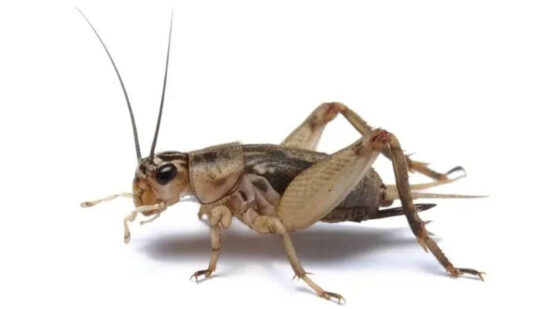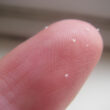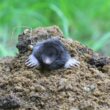Ever wondered what those chirping insects in your backyard munch on all day? Crickets are fascinating little creatures with surprisingly diverse appetites. These small insects are omnivores, meaning they eat both plants and animals. Understanding what crickets eat helps whether you’re trying to keep them out of your garden, raising them as pet food, or just curious about nature.
Crickets play important roles in ecosystems around the world. They help break down dead plant matter, control pest populations, and serve as food for many animals. Let’s dive into the complete guide of what these hopping insects actually eat.
1. Plant Matter: The Foundation of Cricket Nutrition
Plants make up a huge part of what crickets eat in the wild. These little insects are like tiny gardeners, munching on almost any plant material they can find. Grass is probably their most common food since it’s everywhere and easy to reach.
Field crickets can damage many garden crops including beans, beets, carrots, cabbage, cantaloupe, cucumber, lettuce, parsnips, peas, potatoes, and tomatoes. They also love flowers, seeds, and the tender shoots of young plants. In your garden, you might notice crickets nibbling on leafy greens or taking small bites out of fruits.
Some crickets prefer certain plants over others. The foliage of broadleaf plants is preferred over grasses by many cricket species. Weeds are also on the menu, and crickets actually help gardeners by eating weed seeds. Popular plant foods include apples, oranges, bananas, carrots, potatoes, and various leafy vegetables.
The season affects what plants crickets can find. In spring and summer, fresh growth provides plenty of options. During fall, they often switch to eating seeds and dried plant material as fresh vegetation becomes harder to find.
2. Protein Sources: Insects and Animal Matter
While plants are important, crickets also need protein to stay healthy and grow. In nature, they hunt smaller insects and scavenge for animal protein whenever possible. Crickets particularly love to target aphids, those small sap-sucking insects that damage plants.
Other protein sources include ant larvae, small beetles, fly eggs, and even other crickets when food is scarce. When protein and salt are limited, crickets will engage in cannibalistic behavior, targeting weak members of their own species. This might sound harsh, but it’s a survival strategy that helps the strongest crickets make it through tough times.
Crickets also eat dead insects they find. This scavenging behavior helps them get protein without having to hunt live prey. Baby insects, insect eggs, and pupae are all fair game when crickets are looking for their next protein-rich meal.
Some cricket species are more carnivorous than others. While most crickets eat a mix of plants and animals, a few types focus mainly on hunting other insects for their protein needs.
3. Decomposing Organic Matter: Nature’s Recyclers
Crickets are amazing recyclers in nature. These insects are detritivores, which means they eat leaf litter and decomposing plant material on the ground. This cleanup work is actually super important for healthy ecosystems.
Dead leaves, rotting fruit, decaying wood, and even animal remains all become cricket food. They also eat fungi and algae growing on plants or in damp soil. This diet of decomposing matter helps crickets survive when fresh food is hard to find.
After crickets finish eating, they produce waste pellets that break down easily in soil. Cricket manure is sometimes called “gardener’s gold” because it contains many nutrients and improves soil health. Some people even buy cricket waste as fertilizer for their gardens.
This recycling behavior makes crickets valuable members of their ecosystems. They help break down organic matter and return nutrients to the soil, which helps new plants grow.
4. Different Cricket Species Have Different Diets
Not all crickets eat the same things. Different types have developed preferences based on where they live and how they’ve evolved. Understanding these differences helps explain why some crickets cause problems while others are helpful.
Field crickets eat mostly plants but also consume insects and dead organic matter. When they show up in large numbers, they can damage crops. These are the crickets you’re most likely to see in gardens and farm fields.
Camel crickets prefer damp, dark places like basements and caves. They feast on fungus, decaying organic matter, and will even eat fabric and paper if they get into houses. These crickets look different from regular crickets and don’t make the typical chirping sounds.
Mole crickets live mostly underground and prefer eating plant roots and underground vegetation. Their tunneling can damage lawns and crops. If you have spongy areas in your grass, mole crickets might be the cause.
House crickets are probably the most familiar type. They eat a wide variety of plants and insects and are commonly raised as pet food. Each cricket species has adapted to eat what’s available in their specific environment.
5. Baby Crickets Eat More and Different Foods
Baby crickets, called nymphs, have much bigger appetites than adult crickets and eat a wider variety of foods. These little guys are growing fast, so they need lots of nutrition to fuel their development.
Young crickets need high-protein diets to support their rapid growth. Good food choices include rice cereal, wheat germ, and alfalfa seeds. They’ll eat almost anything they can chew, including some surprising household items.
Cricket nymphs will consume cotton, nylon, rubber, leather, and even wood in houses. While this diet won’t keep them healthy long-term, it shows how desperate young crickets can be for food.
In nature, baby crickets eat weeds, grasses, small seeds, tiny insects, and flower petals. They spend about six weeks as nymphs before becoming adults, and they eat constantly during this growth period.
Young crickets also have higher water needs than adults. They need to eat more often and can’t survive as long without food as fully grown crickets can.
6. Household Items: What Crickets Eat Indoors
When crickets get into houses, they become much less picky about what crickets eat. House crickets will eat fabric items like clothing, curtains, and upholstery, especially those made from natural fibers like cotton, wool, and silk.
Paper products are also on the menu, including books, cardboard boxes, and even wallpaper. The glue in book bindings is particularly attractive to hungry crickets.
Pet food left out overnight becomes an easy target. Crickets will also eat crumbs, food scraps, and anything organic they can find. This includes things like houseplants, dried flowers, and even other dead insects.
Crickets are attracted to glues and adhesives found throughout the house. They might chew on furniture, especially wooden pieces, or anything with natural materials.
The key thing to remember is that crickets will eat almost any organic material when they’re indoors. Keeping houses clean and sealing entry points helps prevent cricket problems.
7. Water Requirements: Hydration is Critical
Water is just as important as food for cricket survival. Research shows that crickets with water available 24 hours a day are 32% more hydrated than crickets that only get water for 4 hours daily. Proper hydration also helps crickets grow much better.
A cricket typically needs between 1/4 teaspoon and 1 teaspoon of water per day. In hot weather, this can increase to 2 teaspoons daily. Without enough water, crickets become sluggish and can die from dehydration.
In nature, crickets get water from morning dew, raindrops, and moisture in their food. They also seek out puddles and damp soil when they need to drink.
Crickets can easily drown in deep water because of their heavy exoskeletons, so they won’t enter deep water to drink. They need shallow access to water sources or ways to drink safely without falling in.
The best ways to provide water include shallow dishes with pebbles, cotton balls soaked in water, or special water crystals that hold moisture in a gel form. Fresh fruits and vegetables also provide hydration along with nutrition.
8. Feeding Crickets in Captivity Works Best With Variety
Crickets are omnivores that need a balanced diet of plants, meat, protein, grains, and fresh produce to stay healthy. People raising crickets as pet food need to pay special attention to nutrition since whatever crickets eat gets passed on to the animals that eat them.
Commercial cricket food provides balanced nutrition and makes feeding easy. Fish flakes are excellent protein sources that crickets prefer over most other foods. Cat food and dog food work well too, but should be crushed into small pieces before feeding.
Both wet and dry foods should be available. Fresh fruits and vegetables provide moisture and vitamins, while dry foods like grains and commercial feeds supply protein and other nutrients. Good wet food options include apples, carrots, potatoes, and leafy greens.
Gut-loading is an important process where crickets are fed nutrient-rich foods for 24 hours before being offered to pets. This ensures the pet gets maximum nutrition from eating the crickets.
Food should be checked every two days and uneaten fresh items removed daily to prevent mold and bacterial growth. The ideal temperature for keeping crickets is between 70-75°F with good ventilation.
9. Seasonal Dietary Changes and Availability
Cricket eating habits change throughout the year based on what food is available. Crickets often migrate into gardens during late summer when weeds and wild plants start to dry off and die. This is when they’re most likely to become garden pests.
During spring and early summer, fresh plant growth provides plenty of food options. Crickets can be picky during these times since there’s lots to choose from. They prefer tender young shoots, fresh flowers, and juicy fruits.
Fall brings changes as plants start dying back. Crickets switch to eating more seeds, dried plant material, and stored food sources. They also increase their scavenging behavior as fresh food becomes harder to find.
When food becomes scarce, crickets can enter a state called diapause, which is like hibernation. Their metabolism slows down, helping them survive longer without eating. This adaptation helps crickets make it through winter in areas with cold weather.
Winter survival depends on the cricket species and local climate. Some crickets die off in fall, leaving only eggs to survive until spring. Others may survive in protected areas or warmer climates.
10. Crickets as Garden Helpers and Pests
Crickets can be both helpful and harmful in gardens, depending on the situation. Research from Michigan State University found that a single female cricket ate over 200 weed seeds in just one day. This makes crickets valuable for natural weed control.
Crickets help improve soil by burrowing and moving through the ground, which loosens compacted earth and improves water flow and root development. Their waste also adds nutrients to soil.
Crickets eat many pest insects, helping to control harmful bug populations naturally. They target aphids, small caterpillars, and other insects that damage plants. This pest control service can be very valuable for gardeners.
However, large numbers of crickets can cause problems. They may eat young seedlings, chew holes in leaves, and damage tender plants. According to UC Integrated Pest Management, crickets are rarely serious enough to require control measures in most gardens.
The key is balance. A few crickets in the garden usually help more than they hurt. Problems typically only occur when cricket populations get very large or when they target valuable young plants.
Conclusion
Understanding what crickets eat reveals just how adaptable and important these small insects really are. From munching on garden plants to recycling dead organic matter, crickets play vital roles in nature’s food web. Their diverse diets help them survive in many different environments while providing benefits to ecosystems and potentially to human nutrition.
Whether you’re dealing with crickets in your garden, raising them as pet food, or considering them as a sustainable protein source, knowing about their dietary needs helps you make better decisions. Crickets may be small, but their big appetites and diverse food choices make them fascinating creatures worth understanding and respecting.


